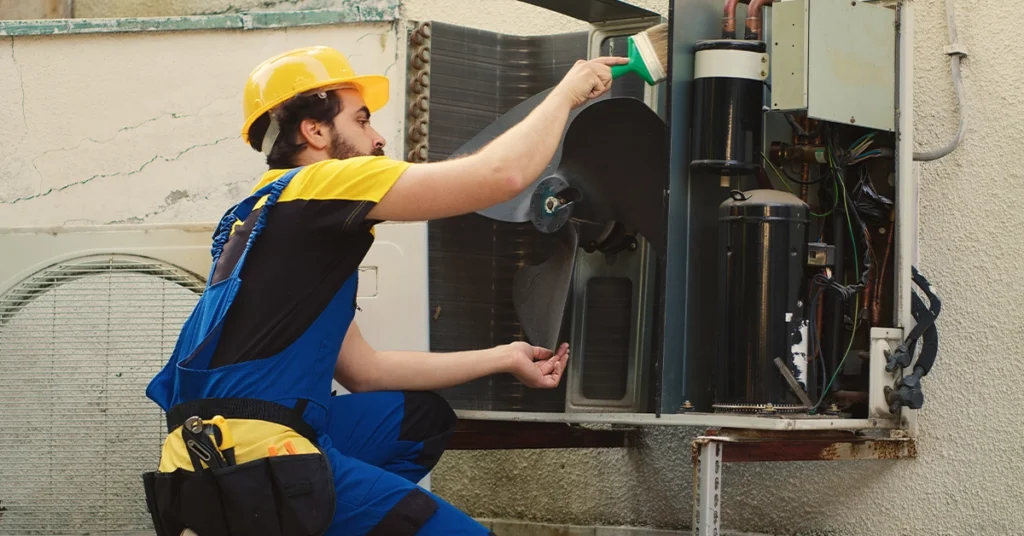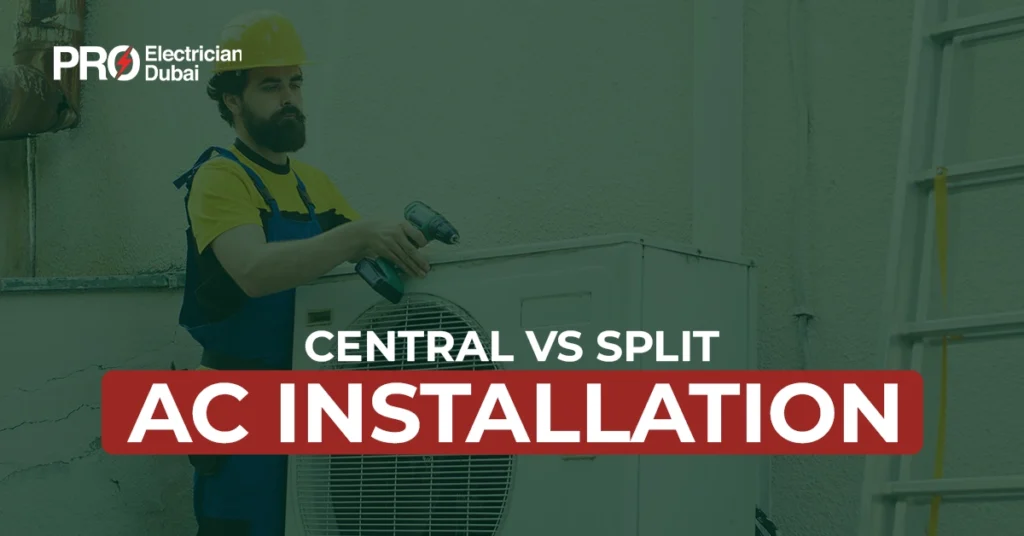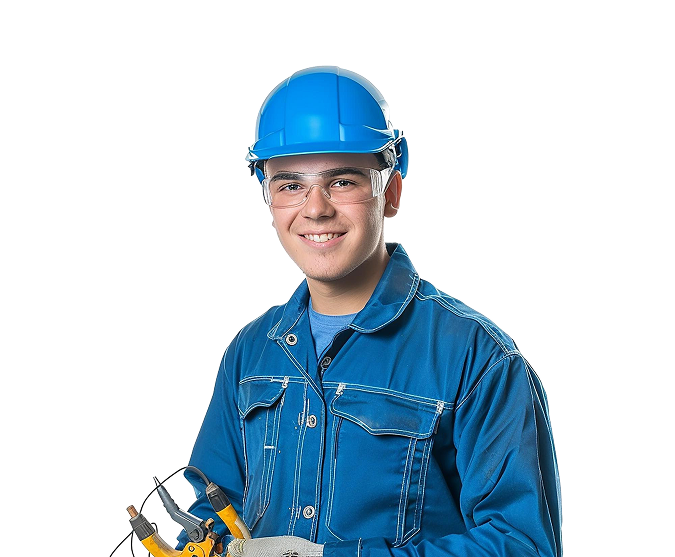As a certified HVAC professional and licensed electrician with over two decades of experience installing, maintaining, and repairing air conditioning systems across Dubai, I’ve worked with everything from ductless mini-split units to central air conditioning systems in villas, apartments, and commercial buildings.
Dubai’s extreme summer temperatures and high humidity demand reliable cooling solutions. The biggest question homeowners often ask me is: Should I install a central AC system or split air conditioners?
Choosing the right AC system depends on your property type, energy goals, and comfort preferences. In this guide, I’ll explain the technical differences, installation costs, energy efficiency factors, and key considerations between central air conditioning systems and split-system air conditioners, helping you make an informed decision for your Dubai home or office.
Understanding Central and Split Air Conditioning Systems
What Is a Central Air Conditioning System?
A central air conditioning system cools the entire property using a single outdoor compressor unit connected to an air handling unit (AHU) and a network of air ducts. The system circulates cooled air through supply vents in each room.
There are two main types:
- Split-system central air conditioner: The indoor unit (evaporator coil and air handler) is separated from the outdoor compressor.
- Packaged central air conditioner: All components are contained in one outdoor cabinet, ideal for rooftops or limited-space applications.
Central AC systems are ideal for large villas, commercial buildings, and multi-room properties where uniform cooling and controlled humidity levels are essential.
What Is a Split Air Conditioner?
A split AC system includes two primary components: an indoor unit (air handler and evaporator coil) and an outdoor unit (compressor and condenser coil). The two are connected by refrigerant lines and electrical wiring.
Ductless split air conditioners and mini-split systems allow you to cool individual rooms or zones without ductwork. Each indoor unit provides personal control, offering flexibility and energy savings for apartments, offices, and attic living spaces.
Central vs Split AC Installation: Key Differences
Installation Process and Complexity
Central AC Installation:
Installing a central air conditioner requires proper duct layout, electrical connections, refrigerant line connections, and thermostat control setup. The process often involves higher labor and material costs, especially in properties undergoing major renovation or home additions. It also requires space for ducting and an air handling unit.
Split AC Installation:
Installing a split-system air conditioner is faster and less invasive. Each indoor unit connects directly to an outdoor compressor through copper ducts and refrigerant lines. No ductwork means minimal structural changes, making it a great option for apartments and smaller homes.
Energy Efficiency and Operating Costs
Central Air Conditioning:
Modern central air conditioning systems feature variable-speed blowers, two-stage compressors, and smart thermostats for improved energy efficiency. When properly installed and balanced, a central AC system can maintain even temperatures and controlled humidity levels throughout the home. However, cooling unused areas increases energy costs.
Split Air Conditioners:
Ductless split systems with inverter technology adjust compressor speed based on demand, improving Seasonal Energy Efficiency Ratio (SEER) ratings and reducing power consumption. Multi-split AC systems allow zoned cooling, so you only cool rooms in use, lowering monthly DEWA bills.
Cooling Performance and Air Quality
Central AC Systems:
These systems excel at whole-home cooling. With proper air filtration, mechanical ventilation with heat recovery (MVHR), and regular filter replacement, central units can improve indoor air quality and minimize noise pollution. They also handle high humidity better due to larger evaporator coils and advanced airflow management.
Split Air Conditioners:
Split ACs deliver focused, quick cooling to specific zones. Each unit has its own air filter, ensuring clean air circulation. However, since multiple units operate independently, they may not achieve the same level of consistent humidity control as central systems.
Installation Costs and Initial Investment
Central AC Installation Costs:
The initial cost of installing a central air conditioner in Dubai typically ranges between AED 1,500 to AED 2,500 per ton, depending on house size, duct design, and system type (split-system or packaged). The cost also depends on whether a natural gas furnace or heat pump is integrated for energy-efficient heating.
Split AC Installation Costs:
Split AC installation is significantly lower, ranging from AED 250 to AED 600 per unit. Mini split units and ductless systems offer flexibility without extensive ductwork, making them a more affordable option for UK households and Dubai apartments alike.
For expert and transparent pricing, explore our Professional AC Installation Services to receive accurate estimates tailored to your property and cooling requirements.

Space and Design Considerations
Central AC:
Because the ducts and air handler are concealed, central AC systems maintain clean interior aesthetics. However, they require significant attic or storage space for duct routing and equipment placement.
Split AC:
Wall-mounted split ACs, ceiling cassettes, or multi-split systems can be installed almost anywhere, with minimal impact on interior design. They’re especially useful in apartments or rooms without false ceilings.
Maintenance, Lifespan, and Reliability
Central Air Conditioning Systems:
With regular maintenance, central AC systems can last 15–20 years. They require air duct cleaning, filter replacements, and thermostat calibration. Neglecting ducts can reduce efficiency and cause dust buildup, affecting respiratory conditions and indoor air quality.
Split Systems:
Split AC units typically last 10–12 years. Maintenance includes cleaning the evaporator coil, checking refrigerant levels, and ensuring electrical connections remain secure. Because each indoor unit functions independently, servicing is simpler and localized.
Energy Efficiency Comparison
For smaller homes or offices, ductless mini-split systems are usually more efficient. They eliminate energy losses caused by air leaks in ducts, offer personal temperature control, and support smart thermostats for automated cooling.
In contrast, central air conditioners are more efficient in large villas and multi-room offices, especially when equipped with multi-stage motors, Daikin VRV systems, and energy standards-compliant components that optimize refrigeration cycles and heat discharges.
Noise Levels and Comfort
Split AC units are quieter because the outdoor compressor is isolated from the indoor space. Central systems can also run quietly when using fan coil systems and variable-speed blowers, but older units may produce more noticeable background noise.
For those sensitive to noise pollution, modern inverter-based mini-splits provide whisper-quiet operation.
Cost Comparison Table
| AC System Type | Installation Cost (AED) | Ideal For | Energy Efficiency | Lifespan | Maintenance Needs |
| Central AC | 2,000 – 6,000+ | Villas, Offices, Large Homes | High for large areas | 15–20 years | Moderate to High |
| Split AC | 250 – 600 per unit | Apartments, Rooms, Offices | Very high (inverter models) | 10–12 years | Low |
Which Is Better for Dubai Homes?
For Dubai villas with multiple rooms, central air conditioning offers superior performance, consistent humidity control, and cleaner aesthetics. For apartments, ductless split systems are more cost-effective, energy-efficient, and easier to install.
If you’re upgrading your home cooling system, consult a certified HVAC technician who can evaluate energy costs, refrigerant line connections, and your property’s airflow design before recommending the right solution.
Conclusion
Choosing between central and split AC installation depends on your house size, budget, and comfort priorities. Both systems can deliver efficient cooling when installed correctly by certified experts.
At Pro Electrician Dubai, we specialize in central air conditioning and split AC installation, offering full solutions from system design to thermostat setup, duct cleaning, and maintenance plans. Our licensed team ensures compliance with Dubai’s safety standards and delivers reliable, energy-efficient cooling for every property type.
Contact Pro Electrician Dubai today for expert consultation and professional installation of your air conditioning system designed for Dubai’s climate, your comfort, and long-term reliability.
Frequently Asked Questions
What is the difference between central and split AC systems?
Central AC cools through ducts, while split AC uses independent indoor units connected to an outdoor compressor.
Which system is more energy efficient?
Split ACs with inverter technology typically have a higher SEER rating and better energy savings for small to medium spaces.
Is ductwork required for central AC?
Yes. Central systems depend on air ducts and vents to distribute cooled air evenly.
Which system is quieter?
Split systems are generally quieter due to isolated outdoor compressors.
What is the average lifespan of each system?
Central AC systems last around 15–20 years, while split ACs last 10–12 years with proper maintenance.
Which is better for Dubai’s high humidity?
Central AC systems handle high humidity and indoor air filtration more effectively.
Can I replace my split AC setup with a central system?
Yes, but it involves additional ductwork, space planning, and higher initial cost.


